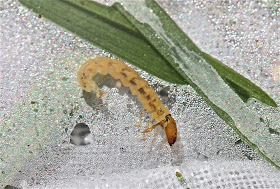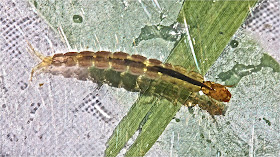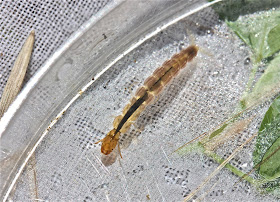Thursday, May 31, 2012
Netspinner Day: Common, Fingernet, and Trumpetnet -- All Three
Along with a friend, I went to a small stream in Sugar Hollow this morning, and we soon agreed that it's probably time to start looking elsewhere if we want to see the new species that show up in the summer.
In these little streams that flow down the mountains and feed into the Moormans the water levels are dropping, and a lot of the insects that flourish here in the winter and spring have hatched and laid their eggs, setting the stage for a new generation. Oh, we did find plenty of insects -- just nothing new and unexpected. The list: flatheaded mayflies, Epeorus pleuralis; the Perlodid stoneflies, Isoperla holochlora and Remenus bilobatus; genus Eccoptura common stoneflies; "baby" Peltoperlids (Roach-like stoneflies), and "baby" Giant stoneflies; and a few Leuctrids -- "Rolled-winged" stoneflies. A few other things, but that's all.
I also found the common netspinner in the photo above, Diplectrona modesta, and a fingernet caddisfly larva, genus Dolophilodes. Both of these "netspinning" caddisfly larvae are intolerant of stream impairment, and we've seen them in these Moormans' tribs before.
Diplectrona modesta:
Fingernet (Philopotamidae), genus Dolophilodes:
On my way back into town, I decided to take a look in the Moormans River itself, where I hoped to see some small minnow mayflies. I didn't. What I did see was something that we often see in the summer in a lot of our streams, a lot of common netspinners, genus Hydropsyche, a fairly tolerant taxon, and a trumpetnet caddisfly larva. The common netspinners were, by far, the dominant taxon in this part of the stream. I see very few of them in the winter, and while numbers increase in the spring, it's in the summer that they seem to flourish in this part of the country.
The common netspinners I saw in the Moormans were different colors -- some gray/brown, others bright green, others still more the color of olive. I suspect they were all Hydropyche in terms of the genus -- that's the most common genus we see -- but the colors and patterns may indicate a difference in species. The North Carolina list of tolerance values has numbers for 12 different species of Hydropsyche, with values ranging from 2.6 to 7.9. Some day, I hope I can figure out which species we find in our streams, but that's a project that's going to take me some time.
This is one that I like to see -- and see it quite often -- because of the pattern.
While the abdominal gills are very clear in this photo, they show up even better when these larvae roll onto their backs -- something they like to do.
This is a photo that also reveals the features that help us determine the genus ID -- the two "sclerites" (dark spots) at the base of the prosternal plate, along with a forked fore trochantin, indicate Hydropsyche.
The trumpetnet caddis (Polycentropodid) has none of those "frilly" gills on its belly. But we can tell what it is when we see the dark spots ("muscle scars") on top of its head. This too is a tolerant caddis, but it's not one that seems to be common in the streams that I visit.
I did find a mayfly nymph in the Moormans about which I was very excited -- the flatheaded mayfly, genus Stenacron. This is the first one that I've seen this year. Unfortunately, while it was swimming around in my bowl, it managed to lose one of its legs and break off part of its tail! But, it's still worth a look for its beautiful colors.
_____________
I also got some photos of one of the Leuctrids that I found in the small stream where we started this morning, and they too are worth a look.
I'm starting to think that the wing pads lighten in color like this right before they turn black.










No comments:
Post a Comment